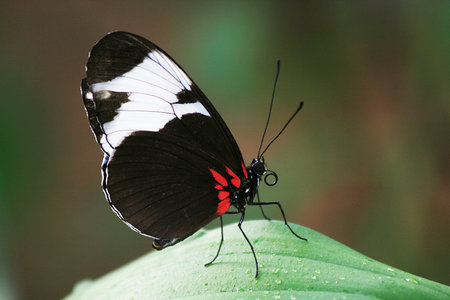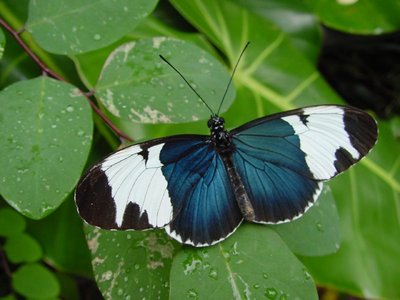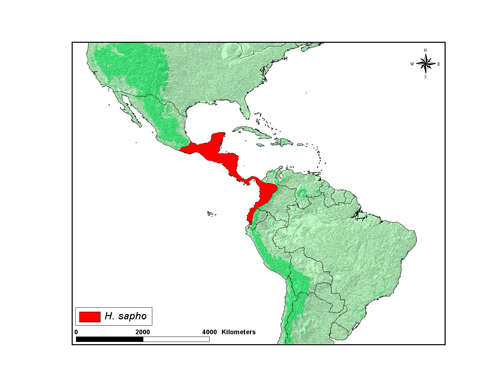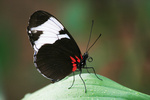Heliconius sapho
Andrew V. Z. Brower and Margarita BeltránIntroduction
Heliconius sapho is a member of the pupal-mating clade of Heliconius butterflies. It occurs in Central and northwestern South America to the west of the Andes. It is a Müllerian mimic with H. cydno, which exhibits parallel geographical variation in the mimetic wing pattern.
Etymology: Sappho was an early Greek poet who lived on the island of Lesbos in the Aegean sea. She ran a school for upper-class young women. Many believe that her poetry shows that she was attracted to her students. Though only a small part of her work has reached us, its raw emotional honesty is timeless. Other (male) poets of the time respected her, and the renowned Greek philosopher Plato was a fan; he called Sappho "The Tenth Muse", giving her near-goddesslike status (Sappho).
Characteristics
Early stages: Eggs are yellow or white and approximately 1 x 0.7 mm (h x w). Females usually place 10 to 40 eggs on growing shoots of the host plant. Mature larvae have a yellow body, with black scoli and head; length is around 0.3 cm. Caterpillars are gregarious (Brown, 1981). Pupae are pale yellow to pale brown, with well-marked black veins and black spines. Pupation often takes place in groups (DeVries, 1997).
Adults: H. sapho has iridescent black wings with a variety of white bands on fore- or fore and hindwings. It can be easily distinguished from its co-mimic H. cydno by the ventral surface of the hindwings, which exhibit basal red rays and no brown bars (see title illustration). Forewing length: 38-42 mm.
Geographical Distribution
Heliconius sapho is distributed from Central America to Ecuador. This map shows an approximate representation of the geographic distribution of this species. The original data used to draw these maps are derived from Brown (1979) which is available at Keith S. Brown Jr. (1979). Ecological Geography and Evolution in Neotropical Forests.
Habits
H. sapho occurs from sea level to 2,000 m in dense forest. Usually individuals fly rapidly and in the canopy. Males often defend territories in small light gaps. The males sit on female pupae a day before emergence, and mating occurs the next morning, before the female has completely eclosed. Adults roost at night in large groups on twigs or tendrils over water (Brown, 1981).
Host plant: H. sapho larvae feed primarily on plants from the genus Passiflora, subgenus Astrophea (Brown, 1981). In Costa Rica H. s. leuce utilize Passiflora pittieri (DeVries, 1997).
Geographical Races
Heliconius sapho exhibits several discrete geographical races over its range, as follows:
- Heliconius sapho leuce Doubleday 1847. southern Mexico to western Panama (Atlantic slope).
- Heliconius sapho sapho (Drury 1782). Panama Canal Zone to northern Colombia.
- Heliconius sapho chocoensis K. S. Brown & Benson 1975. northwestern Colombia (Chocó).
- Heliconius sapho candidus K. S. Brown 1976. Pacific slope of southern Colombia and Ecuador.
H. hewitsoni, which occurs on the Pacific slope of Costa Rica and western Panama is closely-related to H. sapho and considered a race/subspecies of the latter by Lamas (2004).
References
Brown, K. S., Jr. 1979 Ecologia Geográfica e Evolução nas Florestas Neotropicais. Campinas, São Paulo, Brasil: Universidade Estadual de Campinas.
Brown K. S. 1981 The Biology of Heliconius and Related Genera. Annual Review of Entomology 26, 427-456.
DeVries P. J. 1997 The Butterflies of Costa Rica and Their Natural History, Volume I: Papilionidae, Pieridae, Nymphalidae Princeton University Press, Baskerville, USA.
Drury D. 1782 Illustrations of Natural History. Wherein are exhibited upwards of two hundred and forty [two hundred and twenty; two hundred] figures of exotic insects, according to their different genera; very few of which have hitherto been figured by any author, being engraved and coloured from nature, with the greatest accuracy, and under the author's own inspection, on fifty copper-plates. With a particular description of each insect: interspersed with remarks and reflections on the nature and properties of many of them. London, B. White. 3: xxvi + 76 + [2] pp., 50 pls.
Lamas, G. (ed.) 2004 Atlas of Neotropical Lepidoptera. Checklist: Part 4A Hesperioidea - Papiionoidea. Gainesville: Scientific Publishers/Association of Tropical Lepidoptera.
"Sappho" Wikipedia. http://en.wikipedia.org/wiki/Sappho [Accessed Jul 21, 2008].
Title Illustrations

| Scientific Name | Heliconius sapho leuce |
|---|---|
| Location | captive, Botanical Garaden, Munich, Germany |
| Specimen Condition | Live Specimen |
| Identified By | Andrew V. Z. Brower |
| Life Cycle Stage | adult |
| View | ventral |
| Source | IMG_1802 |
| Source Collection | Flickr |
| Image Use |
 This media file is licensed under the Creative Commons Attribution-NonCommercial-ShareAlike License - Version 2.0. This media file is licensed under the Creative Commons Attribution-NonCommercial-ShareAlike License - Version 2.0.
|
| Copyright | © 2008 Marc Aurel |
| Scientific Name | Heliconius sapho |
|---|---|
| Specimen Condition | Live Specimen |
| Source | Heliconius cydno |
| Source Collection | Flickr |
| Image Use |
 This media file is licensed under the Creative Commons Attribution-NonCommercial License - Version 2.0. This media file is licensed under the Creative Commons Attribution-NonCommercial License - Version 2.0.
|
| Copyright | © 2002 Wes Kalinowski |
About This Page

Middle Tennessee State University, Murfreesboro, Tennessee, USA

University of Cambridge, Cambridge, UK
Correspondence regarding this page should be directed to Andrew V. Z. Brower at and Margarita Beltrán at
Page copyright © 2010 and
 Page: Tree of Life
Heliconius sapho .
Authored by
Andrew V. Z. Brower and Margarita Beltrán.
The TEXT of this page is licensed under the
Creative Commons Attribution License - Version 3.0. Note that images and other media
featured on this page are each governed by their own license, and they may or may not be available
for reuse. Click on an image or a media link to access the media data window, which provides the
relevant licensing information. For the general terms and conditions of ToL material reuse and
redistribution, please see the Tree of Life Copyright
Policies.
Page: Tree of Life
Heliconius sapho .
Authored by
Andrew V. Z. Brower and Margarita Beltrán.
The TEXT of this page is licensed under the
Creative Commons Attribution License - Version 3.0. Note that images and other media
featured on this page are each governed by their own license, and they may or may not be available
for reuse. Click on an image or a media link to access the media data window, which provides the
relevant licensing information. For the general terms and conditions of ToL material reuse and
redistribution, please see the Tree of Life Copyright
Policies.
- First online 18 February 2007
- Content changed 12 August 2008
Citing this page:
Brower, Andrew V. Z. and Margarita Beltrán. 2008. Heliconius sapho . Version 12 August 2008 (under construction). http://tolweb.org/Heliconius_sapho/72940/2008.08.12 in The Tree of Life Web Project, http://tolweb.org/











 Go to quick links
Go to quick search
Go to navigation for this section of the ToL site
Go to detailed links for the ToL site
Go to quick links
Go to quick search
Go to navigation for this section of the ToL site
Go to detailed links for the ToL site